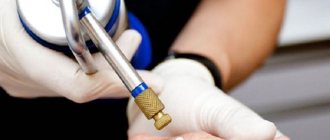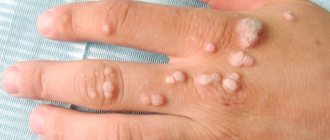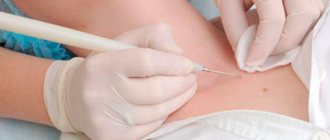Papilloma is a benign formation, the growth of which is caused by the human papillomavirus. In most cases, it occurs against the background of chronic pathologies or weakened immunity. Formations make adjustments not only to the patient’s appearance, but can also affect health. They aggravate breathing, cause discomfort and provoke the development of diseases. Radio wave surgery is used to remove papillomas. What do you need to know about the method, what is it based on and what are the consequences of the intervention?
Prices for visiting a dermatologist
| Name | Price | |
| Removal of benign neoplasms of the skin and mucous membranes using radiosurgery 1 element | 580 ₽ | Sign up |
| Removal of benign skin tumors using radiosurgery up to 1 cm in size | 2500 ₽ | Sign up |
| Removal of benign skin tumors using radiosurgery ranging in size from 1 cm to 3 cm | 2650 ₽ | Sign up |
The clinic provides a certificate for tax deduction.
Why do papillomas need to be removed?
Removal is the only way to get rid of papillomas.
Indications for removal of papillomas:
- The patient’s desire to get rid of physical and psychological discomfort, especially when tumors are localized in visible areas of the skin.
- Traumatization of formations with the formation of bleeding elements and local inflammation.
- Risk of malignancy of some papillomas.
What are the advantages of the radio wave method for removing papillomas?
Removing papillomas using the radio wave method has a number of advantages, including:
- speed of execution and the ability to get rid of all tumors at once;
- painless, contactless and bloodless method;
- minimal risks of secondary infection;
- short rehabilitation period - 7–8 days;
- no need for dressings or visiting a doctor after removal;
- the possibility of performing a histological examination if malignancy of papilloma is suspected;
- the formation of a “delicate” scar or its absence in case of small papillomas.
Dermatologists
- Ayvazyan Linda Volodyevna
Experience: 5 yearsDermatovenerologist, mycologist, trichologist
Rating: 0/5 — 0 votes
Make an appointment
- Osipova Daria Sergeevna
Experience: 14 years
Deputy chief physician for medical work. Dermatovenerologist
Rating: 0/5 — 0 votes
Make an appointment
Radio wave removal is a gentle surgical method for the treatment of papillomas, warts, moles, condylomas and other benign neoplasms. Modern devices make it possible to perform operations on the skin and mucous membranes without the formation of scars. Radio wave treatment is carried out on an outpatient basis by a dermatologist.
At the Kutuzovsky Children's Center you can get rid of skin tumors quickly, painlessly and at a reasonable price. Call us to make an appointment for the procedure. In our clinic in Moscow, you will receive the help of experienced specialists and treatment using the latest radiosurgery equipment.
Indications and contraindications for removal of papillomas with Surgitron
Since the Surgitron method of wart removal has many advantages, many doctors recommend it to their patients. The main indications for surgery are neoplasms and papillomas of various parts of the body. This technique can be used even if HPV is detected on the cervix or vagina. It is also ideal for eliminating tumors on the eyelids and in areas of high humidity.
It is forbidden to use Surgitron if there are signs of malignant degeneration of papilloma.
Contraindications:
- Having herpes.
- Pregnancy.
- Presence of a pacemaker.
- State of fever.
In addition, doctors do not recommend removing papillomas for women during menstruation.
How does the procedure work?
Radio wave surgery for moles and other growths is a method of removing them using radio waves. This method is used along with laser and is considered safe and effective. A gentle incision is made on the skin that does not require suturing.
The procedure lasts several minutes. It all depends on the complexity and type of tumor. For example, radio wave removal of moles takes 10-15 minutes. Radio wave removal of papillomas with multiple rashes requires more time. For maximum patient comfort, local anesthesia is used, which is included in the cost of the service.
Radio wave removal of papillomas and moles with Surgitron
from February 9, 2020
Before removing any skin tumor, especially a mole, it is necessary to conduct an examination of it to establish the nature of the tumor and its benignity.
What research is done before removing skin tumors?
The main optical device used by a dermatologist to examine moles and other skin growths before their removal is a dermatoscope. A dermatoscope consists of a magnifying lens and a light source to improve the visibility of subsurface structures of the skin.
The examination procedure using a dermatoscope is called dermatoscopy . This is a modern hardware diagnostic method that allows a professional experienced specialist to visually assess and diagnose the nature of any skin tumor under tens of times magnification, which reduces the need for expensive and traumatic procedures such as biopsies and incisions.
What are the advantages of the radio wave method compared to other removal methods?
The radio wave method for removing skin tumors is the most non-traumatic procedure, which is based on the use of high-frequency waves (radio waves) on the Surgitron DF 120 device, USA. Our doctors use this method even if it is necessary to remove an element located in a hard-to-reach place (oral mucosa, eyelids).
The advantages of the radio wave method include:
- complete absence of pain during the procedure;
- no bleeding after removal;
- no trace remains at the site of removal;
- no risk of secondary infection;
- healthy areas remain untouched;
- fast healing process;
- The method is universal - you can remove papillomas, moles and even warts.
Important : it is also worth pointing out that one of the main differences between radiosurgery and laser, for example, and other techniques is the ability to perform a histological examination of removed tissues to determine their structure and good quality, if necessary.
Will it hurt during removal?
When removing papillomas and small moles using the radio wave method, no anesthesia is required. Such procedures are painless.
When removing large moles, anesthesia is used - the injection of high-quality anesthetic “Ultracaine” under the neoplasm using a microinjection.
What happens after removal?
During the first day after the procedure, a dark brown crust will form at the site of the removed tumor. Healing takes from 2-3 days to 2-3 weeks, it all depends on the volume of intervention. After healing, the crust will come off on its own. Within 1-3 months, the area of skin at the site of removal has a bright pink color, then it will acquire a normal skin color. If you follow all the doctor’s recommendations and properly care for your skin, no marks or scars will form at the removal site.
Are there any special recommendations for skin care after the removal procedure?
We issue the following recommendations in the form of a reminder to our patients:
- During the first 24 hours, do not wet the removal site.
- Treat the wound with Fukortsin solution 2 times a day for 3-5 days or Baneocin powder.
- Men: do not shave in the area of removal for 3-4 days.
- Women: do not apply cream or decorative cosmetics to the removal area for 3-4 days.
- You cannot pick or remove the crust yourself!!! in order to reduce the likelihood of atrophic/keloid scars, hypo- and hyperpigmentation.
- As a rule, after self-rejection of the crust, the area of skin at the site of removal has a bright pink color and will return to its normal color within 1-3 months.
- In cases of removal of large tumors, after the crust is rejected, apply Levomekol ointment locally 1-2 times a day for a month.
- Before going outside, be sure to use sunscreen on the face and open areas of the body with an SPF of at least 50, especially on sunny days (to prevent pigmentation of the treated areas).
What are the contraindications for removing moles and papillomas?
There are a number of conditions in which it is not permitted to intervene with elements on the skin. These include:
- allergic reaction in the acute stage;
- severe epilepsy;
- hypertensive crisis;
- fever;
- acute respiratory infections;
- herpes (acute stage);
- all cases of malignant neoplasms.
Why is it necessary to remove papillomas?
Papillomas are benign skin growths that are caused by the human papillomavirus (HPV). After entering the body, the virus begins to actively multiply in the surface layers of the skin, causing the formation of skin growths.
These neoplasms rarely degenerate, but being viral in nature, they are prone to spread and grow , causing not only aesthetic problems, but also inconvenience, especially if they are located on the neck, armpits, genitals, and mucous membranes of the eyelids. Removal in this case is the only way to combat papillomas, because others have not yet been invented.
Federal State Budgetary Institution National Medical Research Center of Endocrinology of the Russian Ministry of Health
Did not find an answer to your question? Call and ask the specialists by phone +7 (495) 500 00 97 or write +7 (910) 455 34 97
Share with your friends and acquaintances:
Advantages of the method
Removal of benign neoplasms of the skin and mucous membranes using radiosurgery allows for high-precision treatment of tissue. The doctor achieves excision to a given depth and with the desired incision configuration.
It is possible to perform radiosurgical removal of papillomas, moles and condylomas in areas inaccessible to other instruments, for example, in the genitals.
An important advantage is the absence of a scab. The doctor can visually monitor the process to achieve maximum cosmetic effect.
Other advantages of the method:
- Fast wound healing.
- Minimal damage to underlying tissues.
- Absence of scars after radiosurgical removal of papillomas, some types of keratomas (however, removal of moles does not pass without a trace, minor scars remain).
- Recovery without complications.
- No training requirements.
How exactly is papilloma removed?
Before the procedure, you must visit a dermatologist. This is a mandatory requirement that cannot be ignored. The preliminary consultation is quick. The doctor examines the skin, clarifies complaints, and excludes contraindications. If all points are in perfect order, and the patient wants to get rid of papilloma as soon as possible, the procedure can be carried out immediately after admission.
How does the removal proceed? The patient is placed on the couch and asked to sit comfortably. The doctor then administers an individually selected pain reliever.
This may be a topical cream, an injection under the base of the papilloma, or irrigation of the intervention area with a special spray. Once the painkiller takes effect, the doctor begins the excision. The procedure itself lasts from 10 to 30 minutes and depends on the specifics of the formation, its size/structure, etc. The doctor selects the required distance, intensity, and depth of the wave, after which he acts on the tumor until it is completely excised.
Why are papillomas dangerous?
Those elongated small outgrowths of papilloma that are located in areas of friction can become injured, become inflamed, swell and fester, greatly increasing in size. Some papillomas carry the HPV virus. If they are not removed by radio waves or another method, then one can expect their number to increase exponentially, and the risk of skin cancer to increase. The greatest danger comes from incorrect diagnosis, when papilloma is called cancer, or other diseases that turn into cancer. This is especially true for papillomas in the mouth, tongue, lips, and genitals.
Sign up for a consultation
Equipment
Surgitron is the most famous representative of radio wave devices. However, there are many other brands of similar equipment. Special high-frequency radio waves are generated in radio wave devices. They differ favorably from electrocoagulators in that they do not burn, but detach tissue with lightning speed. There is practically no blood in this case. Neighboring cells not associated with the papilloma remain completely unaffected and capable of regeneration. Thanks to this, wounds heal so quickly after radio wave removal. Also, very little scar tissue is formed.
Preparation and process
How to prepare for the procedure
There is no need to worry before removing warts using the radio wave method. If you have such a tendency, then the evening before and before the procedure, you can drink motherwort tincture or another mild sedative. Half an hour or an hour before the procedure, you can also take a tablet or capsule of your favorite NSAID painkiller (ketonal, analgin, nurofen) in order to more easily tolerate painkiller injections, especially if you plan to remove warts on the fingers or soles of the feet.
Process description
The doctor treats the wart and the skin around it with antiseptics. If necessary, relieve pain by injecting an anesthetic solution under it. Next, he takes a special tool, surgitron, or a radio wave apparatus from another company and works with it.
Radio wave removal
During removal with surgitron, warts are exposed to high-frequency electromagnetic waves (radio waves). The water quickly evaporates from them and they disappear. There are practically no unpleasant sensations. The positive point is that the radio wave knife does not heat the skin next to and under the wart, which causes pain when removed with a coagulator.
What to do after deletion
After removing warts using the radio wave method, wounds remain that need to be taken care of. Depending on the characteristics of the wound and the patient, the doctor will prescribe an ointment or powder with an antibiotic, anti-viral agent, or a medicine that accelerates healing. The wounds on the soles of the feet may hurt when walking, then it is possible to use soft pads and take painkillers in tablets.
Rehabilitation period
Since the electrode does not touch the skin, the likelihood of complications is reduced to almost zero. Rehabilitation is easy and fast. Key recommendations for this period:
- Do not wet the area where for 2 days .
- Do not go out into the sun for several weeks without applying protective cream.
- baths and saunas for several days
- For several days, treat the wound with an antiseptic .
The crust that forms at the site of the surgical wound disappears after 7-10 days. You cannot remove it yourself; this will worsen the cosmetic effect and can lead to infection.
Why and when do you need to remove skin tumors?
If there are suspicious neoplasms, it is better to consult a dermatologist. This is necessary if the defect grows, their number increases, a dark spot forms around, and the growth itself itches and hurts. The decision to remove tumors is made by a dermatologist based on the diagnosis and patient complaints. The type of growth, its characteristics and the likelihood of malignant degeneration are taken into account.
Removal of tumors on the face or other parts of the body is required in the following cases:
- They are located in those areas of the body where they are constantly exposed to friction and have a high risk of damage. These are the areas of the armpits, groin, and inner thighs that are regularly shaved.
- There is a high risk of degeneration. This applies to situations where the growths were accidentally damaged.
- Unaesthetic type of neoplasm. More often this is due to the fact that the mole or papilloma is in a visible place, which causes psychological discomfort to the person.
Causes of neoplasms
Children's skin is especially delicate and has an increased degree of sensitivity to any external influences. Often the cause of the development of skin pathologies is exposure to direct sunlight, from which not only infants, but also older children should be protected. However, this is just one reason. Some skin pathologies develop in children regardless of external causes: neoplasms can be congenital (the reason for this may be, for example, heredity).
Benign formations on the skin of children extremely rarely turn into malignant ones (unlike adults). However, it is worth noting that it is much more difficult to notice this pathology on a child’s body than in an adult. The peak age for the development of skin tumors in children is considered to be up to 8 years of age. Some skin pathologies develop from 8 to 15 years, but in this case they tend to grow slowly and are mostly unnoticeable.
Experts do not recommend that parents worry about every new mole on their child’s body. The fact is that a disease such as skin cancer is quite rarely diagnosed in children. However, there are a number of diseases (for example, congenital pigmented nevi) that require constant medical monitoring. Large pigmented moles tend to increase in size, often change color, and can be injured by clothing - all this can lead a benign neoplasm to transition to a malignant stage. That is why today radio wave surgery is becoming increasingly in demand, making it possible to get rid of unwanted tumors and prevent the risk of developing serious diseases in children. In addition, these operations are also popular from an aesthetic point of view, since large tumors can significantly spoil the baby’s appearance (especially when located on open areas of the body).
Contraindications to radio wave removal of tumors
Radio wave surgery, like any treatment method, has a number of contraindications, for example:
— Herpes and other acute infectious diseases (ARVI, influenza, etc.);
— Pustular skin diseases;
- High body temperature;
— General contraindications to surgery (high blood pressure, epilepsy, etc.).
The operation is prescribed only after consultation with the attending physician and examination of the child for possible contraindications. If it has been determined that there are no obstacles to the surgical procedure, the child is sent for the procedure. First, the doctor talks about the principle of operation of the technique and answers all the parents’ questions.
Features of the procedure
Radio wave removal of small papillomas is not necessarily carried out under local anesthesia. Their base is narrow, and the duration of removal of one papilloma is short. Only the largest of them, or those “papillomas” that are so undeservedly named, make sense to anesthetize. All papillomas are most often removed in one session. In cases of a large number, radio wave removal can be divided into a larger number of sessions. The healing rate is high due to the small size of the wounds remaining at the base of the papillomas. They drag on for several days. It is better to make an appointment in advance in order to have time to carry out radio wave removal of all papillomas and not to rush anywhere










